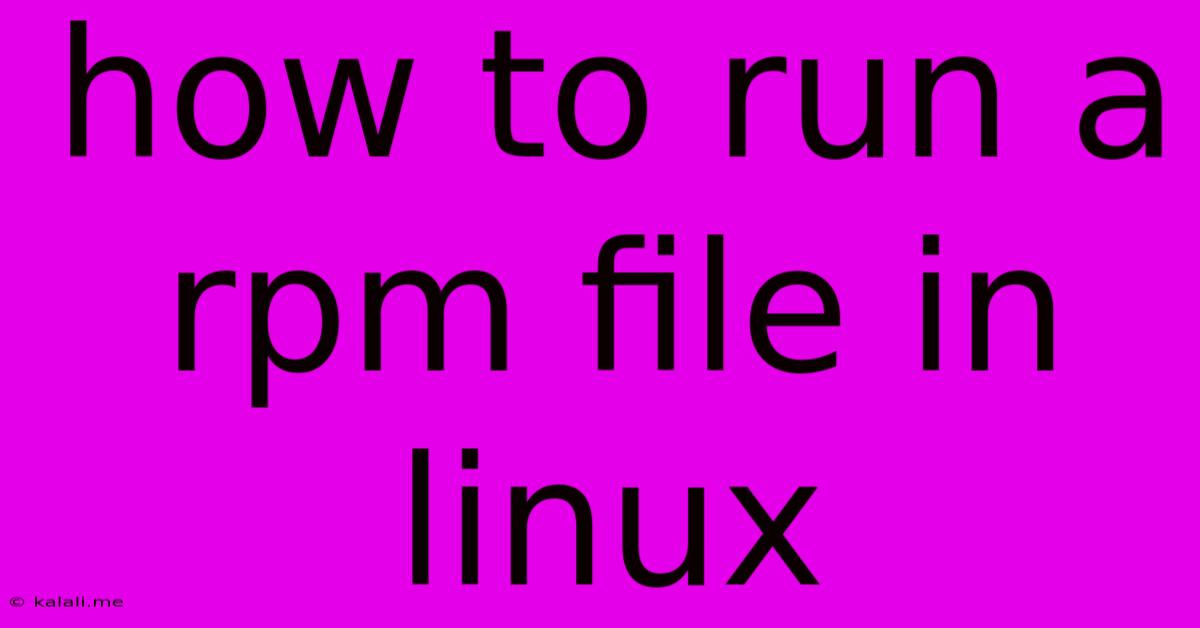How To Run A Rpm File In Linux
Kalali
Jun 07, 2025 · 3 min read

Table of Contents
How to Run an RPM File in Linux: A Comprehensive Guide
Running an RPM (Red Hat Package Manager) file in Linux is a straightforward process, crucial for installing software and managing your system's packages. This guide will walk you through the steps, covering various scenarios and troubleshooting common issues. This article will cover using the rpm command, understanding its options, and addressing potential problems you might encounter. Learn how to install, verify, and manage RPM packages efficiently.
What is an RPM file?
An RPM file is a package file format used primarily in RPM-based Linux distributions like Fedora, CentOS, Red Hat Enterprise Linux (RHEL), and others. It contains the software files, configuration files, and metadata necessary for installation. Understanding this format is key to successfully deploying software in these environments.
How to Install an RPM Package Using the rpm Command
The most common method for installing an RPM file is using the rpm command in your terminal. Here's how:
sudo rpm -i package_name.rpm
Replace package_name.rpm with the actual name of your RPM file. The sudo command ensures you have the necessary administrative privileges for installation. This command will install the package and its dependencies.
Important Considerations and Flags:
-
-Uor--upgrade: This flag will upgrade an existing package to a newer version if one is already installed. If the package isn't installed, it will install it. This is generally preferred over-i. -
-vor--verbose: Use this flag for detailed output during the installation process. This is helpful for debugging if something goes wrong. -
-hor--hash: This flag displays a progress bar during the installation process, providing visual feedback on the installation's progress. -
--nodeps: Use this flag with extreme caution! This flag forces the installation of the package even if its dependencies aren't met. This can lead to instability and system errors. Avoid this unless you fully understand the implications.
Example using multiple flags:
sudo rpm -Uvh package_name.rpm
This command will upgrade the package (if it exists), display a progress bar (-h), and provide verbose output (-v).
Verifying the Installation
After installing an RPM package, it's crucial to verify the installation was successful. You can do this using the rpm command with the -q flag:
rpm -qa | grep package_name
This will list all installed packages and filter the output to show only the package you're looking for. If it's successfully installed, you'll see the package name listed.
Troubleshooting Common Issues:
-
Dependency Errors: If the installation fails due to missing dependencies, you'll need to install those dependencies first. You might need to download and install them individually as separate RPM files.
-
Permission Errors: Ensure you're running the command with
sudoto have the necessary administrative privileges. -
Corrupted RPM File: A corrupted RPM file will fail to install. Try downloading the file again from a trusted source.
-
Incorrect Architecture: Make sure the RPM file is compatible with your system's architecture (e.g., x86_64, i386, arm64).
Beyond Installation: Removing and Querying RPM Packages
- Removing a Package:
sudo rpm -e package_name
This command removes the specified package.
- Querying Package Information:
rpm -qi package_name
This command provides detailed information about an installed package.
This comprehensive guide provides you with the knowledge to effectively manage RPM packages in your Linux environment. Remember to always download packages from trusted sources to avoid security risks. By understanding the rpm command and its various options, you'll be well-equipped to install, manage, and troubleshoot your Linux software effectively.
Latest Posts
Latest Posts
-
Can You Do Nikah Without Parents
Jun 07, 2025
-
Does French Press Work On Induction Strove
Jun 07, 2025
-
Be Ye Perfect As I Am Perfect
Jun 07, 2025
-
Should You Have A Range For Desired Salary
Jun 07, 2025
-
Android Disable Long Press On Home Screen
Jun 07, 2025
Related Post
Thank you for visiting our website which covers about How To Run A Rpm File In Linux . We hope the information provided has been useful to you. Feel free to contact us if you have any questions or need further assistance. See you next time and don't miss to bookmark.